• Take a plastic mug. Drill two holes at its base and fill rubber stoppers in these holes. Insert carbon electrode in these rubber stoppers as shown in Fig.
• Connect these electrodes to a 6 volt battery.
• Fill the mug with water such that the electrodes are immersed. Add a few drops of dilute sulphuric acid to the water.
•Take two test tubes filled with water and invert there over the two carbon electrodes. Switch on the current and leave the apparatus undisturbed for some time.
• You will observe the formation of bubbles at both the electrodes. These bubbles displace water in the test tubes.
Is the volume of the gas collected the same in both the test tubes ? Solution in Punjabi
No, volume of gas in both the test tubes is not the same. Once the test tubes are filled with the respective gases, remove them carefully.
Test these gases one by one by bringing a burning candle close to the mouth of the test tubes.
CAUTION : This step must be performed carefully by he teacher.

Topper's Solved these Questions
- CHEMICAL REACTIONS AND EQUATIONSBOOK - NAND LAL PUBLICATIONCHAPTER - CHEMICAL REACTIONS AND EQUATIONSEXERCISE - ACTIVITY 1.8
2 Videos
- CHEMICAL REACTIONS AND EQUATIONSBOOK - NAND LAL PUBLICATIONCHAPTER - CHEMICAL REACTIONS AND EQUATIONSEXERCISE - ACTIVITY 1.9
5 Videos
- CHEMICAL REACTIONS AND EQUATIONSBOOK - NAND LAL PUBLICATIONCHAPTER - CHEMICAL REACTIONS AND EQUATIONSEXERCISE - ACTIVITY 1.6
1 Video
- CARBON AND ITS COMPOUNDSBOOK - NAND LAL PUBLICATIONCHAPTER - CARBON AND ITS COMPOUNDSEXERCISE - ADDITIONAL QUESTIONS
3 Videos
- METALS AND NON-METALSBOOK - NAND LAL PUBLICATIONCHAPTER - METALS AND NON-METALSEXERCISE - ACTIVITY 3.8
3 Videos
Similar Questions
• Take about 2 g silver chloride in a china dish.
What is its colour?
View Solution• Take three iron nails and clean them by rubbing with sand paper.
• Take two test tubes marked as (A) and (B). In each test | tube, take about 10 ml copper sulphate solution.
• Tie two iron nails with a thread and immerse them 'carefully in the copper sulphate solution in test tube B for about 20 minutes [Fig. (a)]. Keep one iron nail aside for comparison.
• After 20 minutes, take out the iron nails from the copper sulphate solution.
• Compare the intensity of the blue colour of copper sulphate solutions in test tubes (A) and (B) (Fig. (b)].
Also, compare the colour of the iron nails dipped in the copper sulphate solution with the one kept aside [Fig. - (b)].


On the basis of activity , give the answers of th following questions :
What is the colour of copper sulphat solution in test tube A ?
View Solution• Take about 2 g lead nitrate powder in a boiling tube.
• Hold the boiling tube with a pair of tongs and heat it over a flame,
What do you observe ? Note down the change, if any.
View SolutionName the alcohol which constitutes glyceride.
View SolutionIs the product formed on burning magnesium acidic or basic?
View SolutionIn a calomel electrode glass tube is filled with
View SolutionIn a calomel electrode, the glass tube is filled with ________.
View Solution……...बल के कारण पानी से भरा मग जल के अंदर हल्का प्रतीत होता है।
View SolutionAim: To study electrolysis of water. Activity: Take a plastic mug. Drill two holes at the base of the mug. Fix two rubber corks in it, as shown in the figure 1.6. Arrange the test tubes in inverted position such that carbon electrodes remains in it as shown in the figure. Add water in a mug such that electrodes are immersed. Add a few drops of dilute sulphuric acid to water. Connect electrodes to a 6 volt battery. Now, switch on the current and leave the apparatus undisturbed for some time. What is an electrode ?
View SolutionAim: To study electrolysis of water. Activity: Take a plastic mug. Drill two holes at the base of the mug. Fix two rubber corks in it, as shown in the figure 1.6. Arrange the test tubes in inverted position such that carbon electrodes remains in it as shown in the figure. Add water in a mug such that electrodes are immersed. Add a few drops of dilute sulphuric acid to water. Connect electrodes to a 6 volt battery. Now, switch on the current and leave the apparatus undisturbed for some time. Which gas is evolved at anode during electrolysis of water ?
View SolutionAim: To study electrolysis of water. Activity: Take a plastic mug. Drill two holes at the base of the mug. Fix two rubber corks in it, as shown in the figure 1.6. Arrange the test tubes in inverted position such that carbon electrodes remains in it as shown in the figure. Add water in a mug such that electrodes are immersed. Add a few drops of dilute sulphuric acid to water. Connect electrodes to a 6 volt battery. Now, switch on the current and leave the apparatus undisturbed for some time. Which gas is evolved at cathode during electrolysis of water ?
View SolutionAim: To study electrolysis of water.
Activity:
Take a plastic mug. Drill two holes at the base of the mug. Fix two rubber corks in it, as shown in the figure 1.6.
Arrange the test tubes in inverted position such that carbon electrodes remains in it as shown in the figure.
Add water in a mug such that electrodes are immersed.
Add a few drops of dilute sulphuric acid to water.
Connect electrodes to a 6 volt battery.
Now, switch on the current and leave the apparatus undisturbed for some time.

State the chemical equation of reaction of electrolysis of water.
View SolutionAim: To study electrolysis of water.
Activity:
Take a plastic mug. Drill two holes at the base of the mug. Fix two rubber corks in it, as shown in the figure 1.6.
Arrange the test tubes in inverted position such that carbon electrodes remains in it as shown in the figure.
Add water in a mug such that electrodes are immersed.
Add a few drops of dilute sulphuric acid to water.
Connect electrodes to a 6 volt battery.
Now, switch on the current and leave the apparatus undisturbed for some time.

What happens when O2(g) and H2(g) evolved are brought close to the burning candle ?
View SolutionA rubber ball filled with water, having a small hole os used as the bob of a simple pendulum. The perod of such a pendulum
View SolutionA rubber ball filled with water, having a small hole os used as the bob of a simple pendulum. The perod of such a pendulum
View SolutionA rubber ball filled with water, having a small hole is used as the bob of a simple pendulum. The period of such a pendulum
View Solution